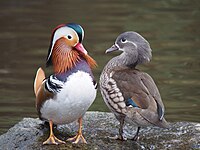
Photo from wikipedia
Sexual dimorphism has often been recorded in apple snails (Caenogastropoda Ampullariidae), but reports are concentrated in a few species, either invasive or with biocontrol potential, which sugests some taxonomic bias.… Click to show full abstract
Sexual dimorphism has often been recorded in apple snails (Caenogastropoda Ampullariidae), but reports are concentrated in a few species, either invasive or with biocontrol potential, which sugests some taxonomic bias. To find out evolutionary and ecological correlates of sexual dimorphism it is necessary to detect and quantify it but also is important to detect its absence. Our aims were to confirm or not the existence of sexual dimorphism in shell shape of Felipponea neritiniformis and Asolene platae, using Pomacea canaliculata as reference and applying the same methodology (landmark-based geometric morphometrics) and statistical power. Significant intersexual differences were only found in P. canaliculata and, in a lesser degree, in F. neritiniformis: males have larger apertures relative to body whorl and more rounded apertural outer edges than females. Female shells are larger in F. neritiniformis and P. canaliculata, but not in A. platae. Using comparable methodologies and statistical power, sexual dimorphism in shell shape is detectable in some apple snails but not in others. Interspecific variation in sexual dimorphism in the Ampullariidae is not only due to taxonomic bias and deserves more research to establish the main patterns and possible causes.
Journal Title: Anais da Academia Brasileira de Ciencias
Year Published: 2023
Link to full text (if available)
Share on Social Media: Sign Up to like & get
recommendations!